The cello and double bass may appear to be very similar instruments but they actually have many differences that are important to know – especially if you’re a strings player! Double basses and cellos, despite looking alike, are actually from different historical string instrument families.
Like the violin and viola, the cello comes from the violin family that was developed in the 16th century.
The double bass, however, is believed to have evolved from the earlier (15th century) viol family – in particular, the violone (which was the bass viol). In fact, early double basses were conversions of violones. This is why many double basses don’t have the pointed corners that cellos, violas, and violins have – their design is more associated with viols than violins.
Corners have also been historically difficult to carve out on an instrument the size of the bass. However, some basses nowadays do have these corners – they’re often referred to as “violin-shaped” whereas the older style is referred to as “gamba-shaped”.
Key takeaways
In a nutshell, what are the differences between cello and double bass?
1. Size
The most noticeable difference between cello and double bass is the size. Cellos are approximately half the size of a double bass and their bows are longer and more slender than a bass bow.
2. Range
One of the most significant differences between cellos and bass in terms of role in the orchestra is the range of the instruments. Cellos have a low C string, which is a minor 6th higher than the low E string of a bass.
3. Strings and tuning
Cellos and basses have different strings and tuning. Like violins and violas, cellos are tuned in fifths (C-G-D-A). Basses are tuned in fourths (E-A-D-G).
4. Sound
Cellos tend to have a much higher sound than the bass. This is both due to range and the physical size differences between the two instruments.
5. Playing position
Both cellos and basses are played in an upright position. However, bassists will usually stand or sit on a high stool to play. Cellists generally only sit on chairs.
6. Role in the orchestra
Historically, the cello and double bass would play the same parts but now cellos operate in a more tenor range while the basses provide deep low end.
Cello vs. double bass – the differences
1. Size
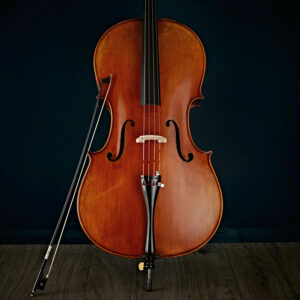 The first difference you’ll notice between cello and double bass is size. In fact, double basses are roughly twice the size of a cello! Some people believe this is where the name double bass comes from, although there are several other theories too.
The first difference you’ll notice between cello and double bass is size. In fact, double basses are roughly twice the size of a cello! Some people believe this is where the name double bass comes from, although there are several other theories too.
The double bass is well-known for being extremely large. Many adults will only play a 3/4 size instrument, compared to the cello where it’s rare for an adult player to play anything smaller than a 4/4 size instrument.
This is because even a 3/4 bass is over six feet (186 cm) tall. A full-size bass stands at six feet and four inches (nearly two metres)! Only very tall players, or those with very large hands, will need a full-sized instrument.
2. Range
The lowest string on a double bass is generally an E. This is a minor 6th below the cello’s lowest string, which is a C.
At the other end of the scale, cellos have a substantially higher range than the bass – up to violin ranges! Cellists can comfortably play up to an F four ledger lines above the treble clef stave. This puts the overall range of the cello at more than four octaves.
The double bass’s upper range maxes out at around a G on the 3rd line of the treble clef. This is about an octave higher than the violin’s lowest string – a respectable range considering how low it can go.
Double basses are also a transposing instrument, meaning they sound an octave lower than what’s notated on the music.
3. Strings and tuning
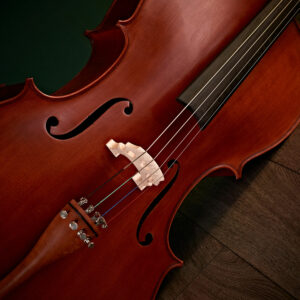 Both cello and double bass have four strings, like the other string instruments. However, this is where the similarities end.
Both cello and double bass have four strings, like the other string instruments. However, this is where the similarities end.
Cellos, like the rest of the string family, are tuned in fifths, meaning there’s a fifth between each string. They’re also tuned exactly an octave below the viola (C-G-D-A).
Basses are tuned in fourths (E-A-D-G), like the lower strings of a guitar. This reduces the range of the instrument greatly but makes it easier to perform quick scalic passages without having to shift around the fingerboard too much.
Some basses can be modified with an extension to the E string to alter its pitch to a C. This lowers the range to exactly an octave below the cello, allowing you to perform passages where the basses double the cello parts.
Bass players may opt to play a five-string instrument. This has an additional lower B string, and it’s extremely deep – within an octave of the lowest pitches humans can perceive! Occasionally, a higher C string may be used instead, though this is more common for solo playing.
Double bassists may also install solo strings on their bass. This is a form of scordatura (alternate tuning) that pitches every string up a tone. These are better for solo playing as the strings are thinner and better for agile playing.
4. Sound
As you may have guessed – cellos are higher pitched than the double bass but both are able to be bowed (arco) and plucked (pizzicato).
They’re also both able to produce beautiful, lyrical bowed passages, with the cello projecting a brighter tone and the double bass projecting a darker tone.
The very thick strings of the bass require more effort and time to get vibrating than the thinner strings of the cello, so basses often have a slower attack on the sound.
Additionally, the double bass is more well known for its ability to be plucked – this is due to its popularity in many genres outside of orchestral music. It’s an iconic jazz instrument and is also seen in many different folk ensembles too, primarily played pizzicato rather than arco.
5. Playing position
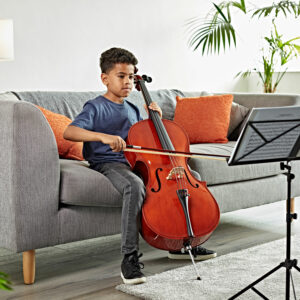 Both cello and bass are played in an upright position – unlike the violin and viola.
Both cello and bass are played in an upright position – unlike the violin and viola.
The cello is usually played with the cellist seated. By adjusting the height of the spike (the endpin), the instrument is placed so that the body rests against your chest. Its neck should be on your left and the lowest tuning peg should be about the same height as your ear. You hold the cello in place with your knees.
The double bass can be played either stood up or sat on a high stool. This is often down to the preference of the bassist – some prefer to stand while some prefer sitting. In jazz and folk ensembles it’s more common to just stand.
Bassists will often bring their own stools with them to rehearsals as some venues might not have suitable stools. They also may just prefer the familiarity of their own stool.
To hold the bass, you first need to adjust the spike so the nut at the top of the fingerboard is about level with your eyes. If you’re standing, your feet need to be about shoulder-width apart.
Tilt the bass slightly so it rests on your left hip; you should be able to bend over and reach the higher notes lower down on the fingerboard without the shoulders getting in your way.
Ideally, you should be able to hold the instrument simply with your body – your hands shouldn’t be needed to hold the instrument. This applies to cello and double bass.
Double basses have two different styles of bows: French and German. The French style is the same as the cello bow, in which you can hold the bow in an overhand fashion. German bows have a much bigger frog and larger gap between the hair and the stick. You hold this bow in an underhand style from the frog.
These bows are very similar; players tend to simply have a personal preference for one over the other. However, some say that the French bow is better for control in soloistic playing while the German bow is better for overall power in orchestral playing.
6. Role in the orchestra
The role of the cello and bass has evolved over time. In the Baroque era, basses and cellos made up part of the basso continuo – a group of lower-pitched instruments that all read from the same bassline. The bass would often play an octave lower than the cello.
This trend continued into the Classical period; many of Mozart’s works and Beethoven’s early works feature combined cello and bass parts.
As the Classical period progressed into the Romantic period, the modern double bass began to appear and composers wrote specific parts for it that were separate from the cello.
These would take advantage of the different tuning on the strings, lower pitch, and generally more percussive sound of the bass.
Today both the cello and basses can provide the bassline – but the cellos can play higher, or tenor, parts in the harmony and even melodies. Some composers do compose melodies and solos for bass, but this is less common.
Benefits of playing the cello
Playing the cello has many benefits. There’s a vast repertoire out there, and you’ll be able to find pieces to play for your whole playing career pretty easily.
If you want to play a mixture of melody lines and bass, the cello is probably better than the bass for you. Cellos can play upper melodies as well as more rhythmic and deeper bass lines.
It’s also generally regarded as less physically demanding to play than bass. If you want to spare your fingers from punishment, opt for the cello.
The cello is much more portable than the double bass; you can carry it on your back and take it with you easily on buses, trains, and taxis without much bother. Basses are much tricker to travel with as they’re larger and won’t fit in all cars.
Our cello recommendations
Student Full Size Cello with Case by Gear4music
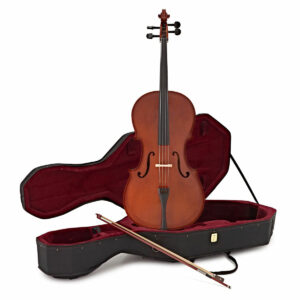 Pros
Pros
Spruce and basswood body delivers a rich sound
Includes everything a beginner needs to get started
Cons
Only uses factory strings
The Student Full Size Cello by Gear4music is ideal for cellists who are just starting out and are looking for a balance between affordability and quality.
Its laminated spruce and basswood body produces those rich, warm cello tones that have inspired you to pick up the instrument in the first place, and it’s varnished for a gleaming finish. The varnish also protects the wood, further enhancing the tough, sturdy build of the cello. Better still, there’s inlaid purfling, which reduces the chance of cracks forming at the edge of the instrument and allows the top to flex more freely, creating a beautiful, resonant sound.
As well as producing a crisp tone, each of the steel core strings has silk wrappings. This is ideal for helping students identify the notes whilst they’re learning.
The complete package, this Gear4music cello comes with a bow, rosin, and case. Robust and durable, the bow is made from hardwood and boasts a half-mounted frog and ebony adjuster. The bow has been designed to be as comfortable and hard-wearing as possible, sticking with you as you progress in skill and learn new techniques.
The case is easy to carry and transport thanks to shoulder straps and wheels on the bottom, whilst its hard foam, canvas-covered construction ensures it keeps the cello well protected as you go from lesson to lesson or gig to gig.
Shop now | Student Full Size Cello with Case by Gear4music
Primavera 100 Cello
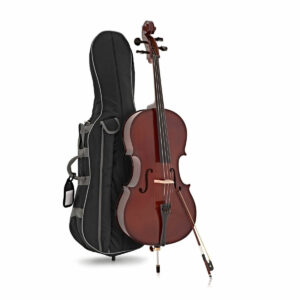 Pros
Pros
Hand-carved maple and spruce body
Comes with a case and bow
Available down to a 1/16 size
Cons
Bow is only half-mounted
Only uses factory strings
The Primavera 100 Cello is a great quality cello if you want a premium start to your playing career. Its body is hand-carved from solid pieces of wood, a step up from many beginner instruments made from plywood which generally doesn’t sound as good but is more affordable than solid wood.
It’s also available in sizes all the way down to 1/16 size, so anyone – no matter their age – can play this cello.
Many beginner instruments come with basic unbranded strings. These are often referred to as “factory strings” and are usually cheaper than strings made by specialised string makers. However, they don’t offer the same sound or performance quality as some branded strings. They’re still fine for your first steps at cello; you can always buy a new set when you want to upgrade.
As with most cello outfits, this one comes with a case and a bow. The bow is half mounted, so there isn’t a metal plate between the frog and the stick. This means that the tightening and slackening of the stick isn’t as smooth as a mounted stick, and it will be worn out quicker – but the overall performance of the bow isn’t very different.
Shop now | Primavera 100 Cello
Stentor Student 2 Cello
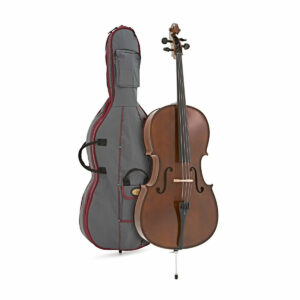 Pros
Pros
Carved body
Bow is fully mounted – lasts longer and feels nicer when tightening and slackening
Available down to 1/16 size
Cons
Uses factory strings
Again, the Stentor Student 2 Cello features a carved body – the wood has been made to a consistent thickness to ensure a reliable tone across all registers of the instrument.
Ebony has been used for the fingerboard, tuning pegs, and the bow frog. This is a premium wood often seen on professional instruments and it’s great for parts like the fingerboard and frog because it resists the oils in your hands. Plus, the softness of the wood makes handling very comfortable.
The bow is fully mounted. So when you’re tightening and slackening, it will feel extremely smooth and the extra metal plate reduces the wear to your bow’s stick.
It’s also available as small as 1/16 size, making it accessible to young players.
Shop now | Stentor Student 2 Cello
Hidersine Veracini Cello
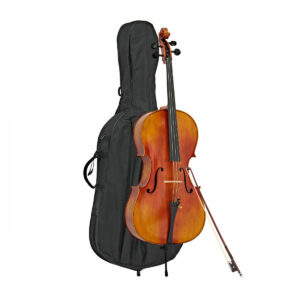 Pros
Pros
Hand-carved from high-quality wood
Beautiful flamed patterning on the back
Top quality bridge from Aubert
Cons
More suitable for advanced players than beginners
Bow doesn’t have the same quality as more premium bows
Only available in 4/4 size so less suitable for younger players
The Hidersine Veracini is very much intended for a more advanced player. It’s more expensive than the previous cellos on this list, but its materials are definitely worth the extra cash.
The wood of the Veracini is usually aged, or “seasoned”, for many years, sometimes decades. And it’s very high quality – the flamed maple back is a shining example of this.
Hidersine’s Veracini has also been made largely by hand. This means that, alongside the body, the neck and scroll have been skilfully carved by a trained luthier.
Plus, Hidersine have set up each instrument in their UK-based workshops so that they’re “ready to play” pretty much straight away.
Shop now | Hidersine Veracini Cello
Benefits of playing the double bass
If you love underpinning an orchestra, the double bass is a no-brainer. It’s nearly unmatched in its low range – only tuba and contrabassoon have comparable ranges.
You’ll also love playing bass if you’re interested in playing other genres. Bass is seen everywhere, from jazz to folk and even popular music.
Playing bass guitar also can also be a natural transition for a double bass player as it has the same strings and similar gauges. You only need to adjust the playing position and alter your fingering slightly to account for frets.
If you’re a fan of musical gadgets and accessories, the bass is also a fun instrument to play. There are all sorts of things out there to make your life easier. You can get wheels/buggies to make carrying your bass around more manageable, you can get a bow quiver to put your bow easily within reach if you need to play pizzicato, and there’s also a large selection of stools you can get.
One of the biggest benefits of playing the double bass is that you’ll get lots of work and opportunities to play. Double bassists, especially classical bassists, are quite rare and you’ll find that your playing skills will be in quite high demand!
Our double bass recommendations
Student Full Size Double Bass by Gear4music
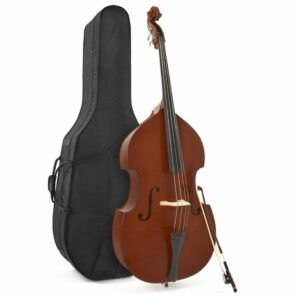 Pros
Pros
Spruce and basswood body produces a rich, warm sound
Ebonized hardwood fingerboard prevents the build-up of moisture
Cons
Only used factory strings
Like the cello, the Student Full Size Double Bass by Gear4music includes a bow, rosin, and hard case, and it’s ideal for beginners. It boasts a laminated spruce and basswood body that produces beautifully warm and resonant tones, and it’s extremely hardwearing – which makes the constant playing and transporting of your instrument a breeze.
As well as inlaid purfling for protection against cracks, the instrument also boasts an ebonized hardwood fingerboard. This clever construction prevents the build-up of moisture, which, therefore, ensures the instrument lasts as long as possible. Plus, to make life easier when you’re learning, the steel core strings have silk wrappings which help you identify the notes.
The Student Full Size Double Bass comes with a bow, rosin, and case – everything a student needs to get going straight away. Crafted from hardwood, the bow is extremely robust and comfortable to use, and the case boasts wheels and shoulder straps for stress-free transportation.
Shop now | Student Full Size Double Bass by Gear4music
Hidersine Inizio Double Bass Outfit
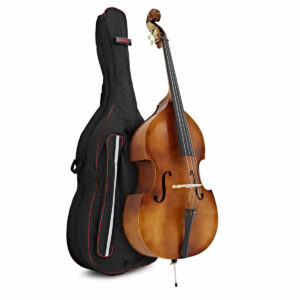 Pros
Pros
Great for students looking for their first bass
Comes with a bag and bow
Very affordable
Cons
Less suitable for older or taller players as it’s only available in 3/4 size
Laminated woods may not offer the same tonal quality as solid wood
Double basses are notoriously expensive; they’re not very common and they’re massive. So finding a double bass for just over £1000 is a bargain. The Hidersine Inizio is a great instrument for people who are just starting out or find other basses prohibitively expensive.
The body is made of laminated woods, which generally aren’t considered to sound as good as solid carved wood basses. You won’t normally see a laminate bass in professional orchestras.
That being said, laminate has advantages over solid wood. It’s less prone to cracking than solid wood and it’s more resistant to changes in temperature or humidity. As a result, these basses are often preferred by buskers or other travelling bass players.
Shop now | Hidersine Inizio Double Bass
Stentor Student Double Bass
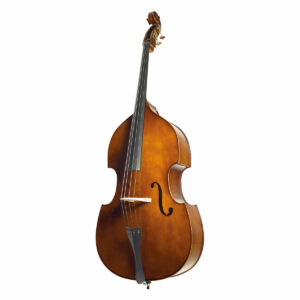 Pros
Pros
Available from 1/16 to 4/4 size
Top is carved from solid wood
Great for beginners or intermediate students
Comes with bag and bow
Cons
Not as suitable for professionals
Like the Student Cello, the Stentor Student Double Bass is a great instrument for beginners. It’s not too expensive and is of good enough quality to last you many years of playing before purchasing a new one.
What makes this bass especially suitable for learners is the broad range of sizes that are available. From a tiny 1/16 size to a full-size instrument, there will be one that fits you.
It also has a fully carved top with laminate sides. This is a great idea because it makes the instrument affordable. The top though, is what has the biggest impact on sound. Making the top out of solid wood vastly improves the sound quality.
Shop now | Stentor Student Double Bass
Stagg Electric Double Bass
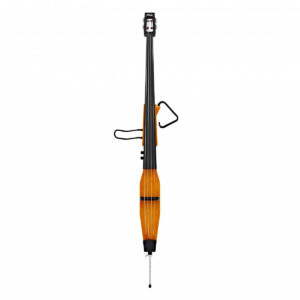 Pros
Pros
Much more portable than an acoustic bass
Extremely eye-catching
Tone controls let you fine-tune the sound
Experiment with pedals and other digital effects
Comes with a specially designed bag
Cons
Sound isn’t as full-bodied as an acoustic
You need an amplifier to plug into
Only available in ¾ size – less suitable for younger players
The dream of many double bassists is to have an instrument that is (relatively) more portable than their acoustic bass. Electric double basses fulfil that role. They also look really cool!
Unfortunately, many electrics are – like their acoustic counterparts – very expensive. But Stagg have achieved the tricky goal of producing a relatively affordable electric bass.
One thing to remember about electric double basses is that they won’t sound quite like your acoustic. They haven’t got the massive wooden chamber in which sound can resonate. But you can still get an authentic sound from it plus the extra fun of experimenting with different amplifiers and effects pedals.
The Stagg bass even comes with a specially designed case so you can carry your instrument around more easily than an acoustic.
Shop now | Stagg Electric Double Bass
Final thoughts
Let’s recap a few of the differences between cello and double bass. Most notably, cellos are smaller and have a larger and higher range than the bass.
Both can fulfil similar roles in an orchestra, but the basses provide more of a percussive low end than the cellos thanks to their extra low strings.
Cellos are generally better at melodic playing, though the double bass has been known for some great melodic moments. Both are fully capable solo instruments too.
Cellos are almost always played whilst sat down, though some electric cellos have extra long spikes which can enable the player to stand. Bassists will sit or stand depending on their preference and what the situation requires.
We stock a good range of both cellos and basses, including fractional-sized instruments for children and some full-sized double basses for taller players. Take a look at our full range below!

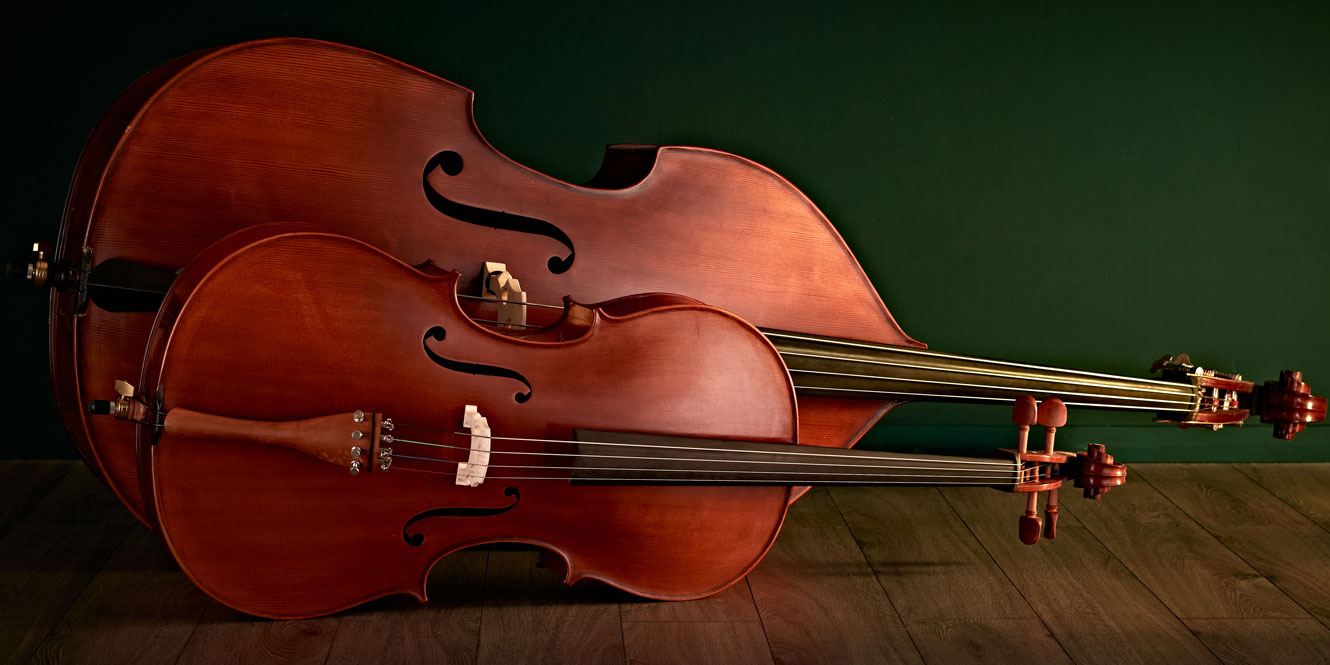











0 Comments